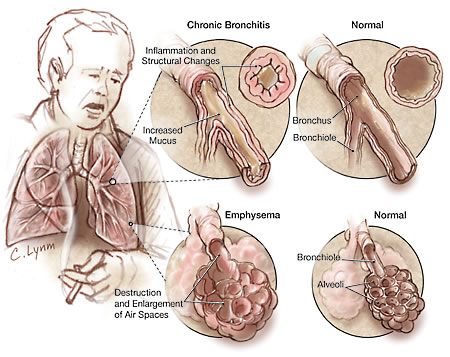Does the term COPD sound familiar to you? Do you smoke? Are you subjected to passive smoking? Have you ever read about the air quality levels in your metro? No?
Here are eight things you need to know!
1. So what is COPD? It sounds Greek and Latin to me
COPD in medical terms is Chronic Obstructive Pulmonary Disease. In simple terms, your airways to your lungs get narrowed. As the airways are obstructed, you get shortness of breath
2. Why is it dangerous?
Due to breathlessness and lack of secretions, the lung tissues will get affected in the long run. There is a 80% chance for COPD patient to be affected by Lung cancer. In fact, COPD is the 6th leading cause of death in the world and will become the 4th leading cause of death by 2030. It’s currently the 4th leading cause of death in US
Pic Courtesy:www.nursingcrib.com
3. What are the main causes for this disease?
Cigarette smoking is the leading cause of COPD in the world. More than 80% of the patients in US are cigarette smokers. In India, 5 % of the adults are affected by COPD. The main causes for this disease in India are smoking and tobacco usage
4. But I don’t smoke; hope I will not get affected by COPD?
There was research conducted in 2007 among slum dwellers in Pune and over 50 % of the non-smokers were affected by COPD. There are other reasons for people getting affected with COPD. It includes air pollution; occupational exposures like mining, construction, welding, passive smoking, wood smoking, and even long exposures to dust may cause COPD. Dr Madhu, Pulmonologist from Frontier Lifeline adds “Most often, there are traces of black spots on every Indian’s lungs, whether smoker or a non-smoker. Much of this is due to poor air quality. Smokers are definitely at a greater risk”
5. What are the symptoms for the disease?
- Long history of smoking
- Consistent cough and excessive sputum production
- Shortness of breath during normal conditions
- Limitation of airflow to the lungs
- Rapid breathing
- Wheezing sounds and enlargement of the chest
Advanced COPD patients may even have direct respiratory failure, which is quite dangerous. But the most common symptom is shortness of breath. Have yourself tested, if you observe the above symptoms
6. So how can we test for COPD?
The most usual test to diagnose COPD is through Spirometry – a test that measures breathing. A few advanced methods like Chest Tomography can also be made for COPD. But a basic Spriometry test will diagnose the presence of COPD
Pic Courtesy: NY Times
7. Our medical methods are advanced. I hope there is some cure for this disease?
The disease is not curable. In terminal stages, lung transplant is the only option. You can either prevent or treat for COPD not cure it. The cost of treating the disease is quite high and spending in India is unknown. So for a country like India, preventing the disease is more important than treating the patients There are more than 250 Million tobacco users in India (according to WHO) and they are prone to COPD more than anybody else. Creating awareness is the need of the hour.
8. How to prevent COPD?
- Creating awareness against smoking and helping people to rehabilitate from smoking addiction
- Creating awareness about air pollution and strict enactment of pollution laws
- Poor people who work in the mines, construction sites etc., are the most prone to such diseases and providing them better living conditions will help in preventing the disease
Today is World COPD Day; share this article with your friend who you think could be prone to this disease. Frontier Lifeline is conducting free Spirometry test and pulmonary consultation for people registering for the same on 17th Nov 2010. Spread the for those for whom it would be helpful
You can also check our blog posts on Lung Carcinoma and Why you should quit smoking








